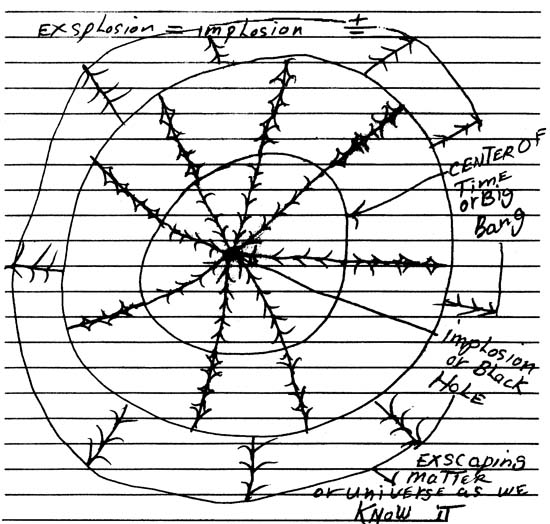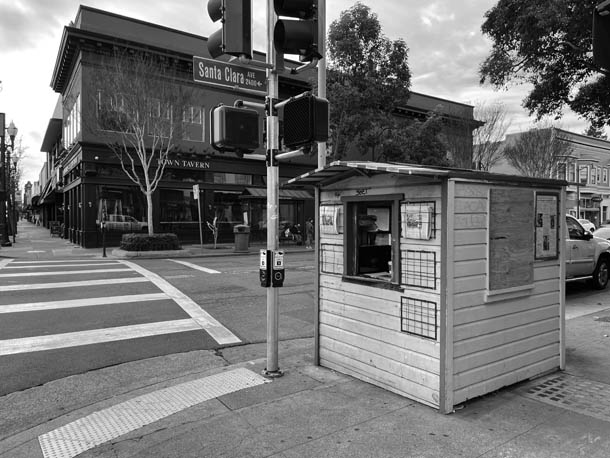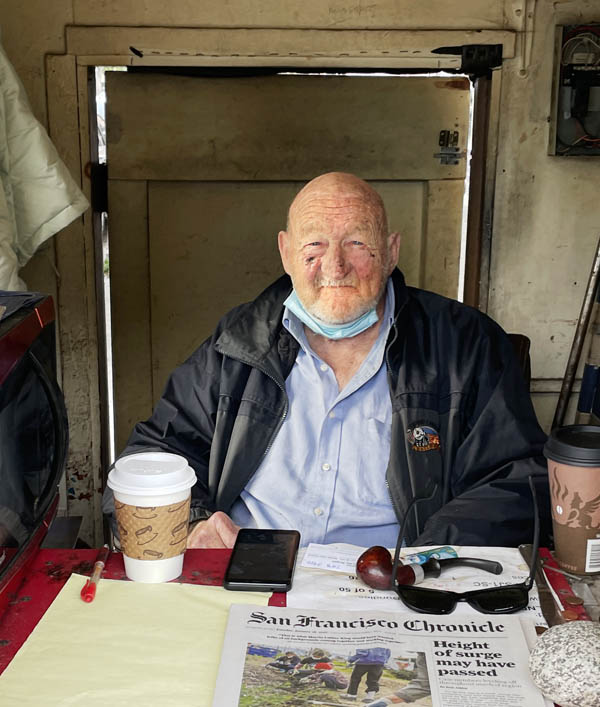Interviewsand Articles
Bob's Think Tank : Best of the Archives
by Richard Whittaker, Apr 2, 2007

For eight years I lived in the island community of Alameda across the bay from San Francisco, a place long-time residents sometimes referred to - not always in the spirit of civic pride - as "the isle of style."
When I discovered Alameda in the late 1960s it seemed I'd entered a place fallen out of time. That impression eventually drew me to move to the island where my wife and I stayed for eight years. It was a seminal period in which I entered the world of publishing. Zines had been flourishing with the advent of desktop publishing and, with no intention of entering that arena, it happened that the tools needed for doing so were close at hand. I was working on a Master's degree and my wife was working at the Maritime Museum in SF as their exhibit designer. I had a Mac Plus. She was using an HP scanner and Pagemaker at work. I was curious about the scanner and how she was designing signage for the Museum. So it wasn't a great leap when one day I had one of those moments—seeing how easy it was to scan images and add text, I realized a magazine was just waiting to be born.
Its beginning happened without the slightest plan, and that's another story. The Secret Alameda #1 was an 80-page, hand-stapled affair born in December of 1990. At forty-seven, I was a generation behind the young publishers setting out on their zine-journeys and, in keeping with my age, this would be a magazine.
There were advantages in the late start. Over the years I'd lived a wide variety of experiences and what flowed immediately into this new space for expression was humor, not a little irony and an eye for the off-beat. At the same time, and more importantly, something deeper lay below all that. Eight issues appeared over a period of four and a half years.
The Spanish word alameda means "public walk, avenue." The magazine's title was intended as a metaphor: a hidden avenue, an interior thing, an inner reality. I was not surprised that most people living in Alameda assumed the magazine was about the place itself. Of course, that was part of it.
This excerpt from the editor's statement in issue #1 gives an account of the not yet fully formed, but real hope contained in its beginning: "There are many things we don't know about The Secret Alameda. One of the most obvious is that we don't know where it is. It's not a simple matter and not limited to this small island. This is a beginning with the hope of making contact. We will be waiting for clues that come our way: writings, drawings, cryptological signs… We're not sure what to expect."
A favorite example of material that found its way into the magazine, was "Bob's Think Tank." It appeared in issue #5 and then later, in an expanded version, in w&c #13.
In 1992, on Alameda's main street in its east-end business district an old-fashioned newsstand was still in operation. Framed on either side by racks of newspapers for sale, its proprietor Bob played his role as if sent from central casting. Picking up a copy of the San Francisco Chronicle while exchanging a few pleasantries with Bob became an almost daily habit. Sometimes they wandered into surprising territory.

One day it was the Big Bang. Maybe Bob had read a recent article. In any case, he'd been thinking about it. Somehow, the image of him tucked into his little booth on the corner of Park Street and Santa Clara Avenue wearing his vendor's apron and holding forth on cosmology was one of those moments. They can never be anticipated. But it's one I quickly embraced.
By then four issues of The Secret Alameda had been published. I was always alert to discoveries that might be right for the magazine. I never knew what they might be, but they always revealed themselves by their vibration or tone - something like the sound of a bell. This was one of them, and it felt like a small bonanza. So I was a ready listener.
In response to my interest, I noticed an uptick in Bob's metabolism as he shared his musings. They weren't so easy to follow, but afterwards, I scribbled a few notes from memory:
Standing in a room watching the rays of light entering through the panes of glass and piercing the dark shadows and striking the walls, I pondered a beam of light and my position in time.
If you can look through a telescope and pick a position in time on a beam of light and wait for that position in time on a beam of light to reach your position in time, you have looked into the future, met the present - oh, and then that position in time on a light beam passes my position in time. I should be able to see into the past... true (said as if to himself).
Bod did his best to explain it all to me. He'd even made a sketch to illustrate the way the Big Bang worked, which he pulled out to show me. Could I photograph it? I asked.
"Why don't you keep it?" he said, generously, giving it to me to study later.

On another day, I learned from Bob that before his time, under the guise of "civic improvement," there'd been a concerted effort to eliminate the newsstand. The east-end business district of the island’s bipolar commercial topography was held to be a cut above the west-end district which featured businesses that had sprung up catering to military personnel stationed at the Alameda Naval Air Base. Its influence goes back to 1936, and even earlier. There were liquor stores, tattoo and massage parlors and so on. In those days, having a tattoo bespoke a rogue streak not so appealing to respectable citizens. (But to be fair, Alameda's liquor stores and bars seem evenly distributed across the island to better serve the alcoholic needs of all its residents.)
In any case, in the wake of earlier improvements to the island in the form of huge landfills extending its the western edge further into the SF Bay, developments like the Southland Mall and condominium complexes sprung up. In the light of this kind of progress, many forward-looking residents viewed the newsstand as an eyesore. Certainly, in comparison with Mervyn’s, Target and other big-box retailers at the new mall, it was a relic of bygone times.
As Bob shared with me that morning, one irate citizen had likened his newsstand to "a wretched coop." But as always, there were advocates on both sides of the controversy. The battle raged with a volleys of fervent letters appearing in the pages of both the Times-Star and the Alameda Journal. One correspondent saw the newsstand as "one of the finer cultural artifacts on the island." A gibe, probably, one that worked well in either direction.
That was all history, however, as Bob was telling the story. In my years of living in Alameda, a morning visit to the newsstand along with a fresh cup of coffee always helped frame the day ahead in a positive light. Finished were the curses aimed at metal boxes that, fed quarters, refused to open. Instead I could enjoy that old-fashioned pleasure of relationship with a fellow human being.
It turned out that only the island's residents who were subscribers to The Secret Alameda (all one hundred and fifteen, or so) ever learned about the newsstand's hidden identity—that inside that little structure, one man was thinking about things - thinking seriously, even cosmologically. The newsstand was, I had realized with a sudden kind of joy, Bob's think tank.
Post Script
Looking through the conversations.org website one morning, I ran across the expanded version of Bob's Think Tank I'd written for works & conversations #13 in 2006. Fourteen years had passed since its appearance in The Secret Alameda #5. And nineteen more years had passed since then. Revisiting the story took me back over thirty years. And once again, I felt compelled to write a little more about the whole thing. Its transformation from being just a newsstand into being its proprietor Bob's think tank had been, for me, both pricelessly droll and an exemplar of a speciifc reality - unknown in its extent - that is, the natural pondering of the mystery of life that takes place among people - pondering done without institutional certification and without an intended audience save, perhaps, a family menber and a friend or two, but no less authentically. We never hear about it and, truthfully, one wonders how much such a natural pondering of deep questions still takes place, given the media trance in which we now live and which deprives us of those moments of pondering that can flower while sitting alone and out of reach of those devices that whisper their beguiling call without ceasing.
And so I ran across the article. It was on the morning of January 24th, 2022. Once again, l savored the memory and then, suddenly, I wondered: does the old newsstand still exist? Could it possibly?
There was only one thing to do. Thus it was that I found myself moving slowly through traffic lights on Alameda's Park St. making my way toward Santa Clara Ave. I did not expect to see anything, and yet, who knew? I couldn't rule it out.
As I came closer on a slow roll down the street it was as if I was trying to pull the car closer with my eyes, straining to see — and suddenly, there it was. A little wooden structure. And then I was able to make out, yes, two newspapers - one on either side of its little window. The newsstand was still there! I felt both a surge of joy and sadness at the same time. It was there, but so reduced.

I turned right and found a place to park on Santa Clara. As I walked toward the newsstand all I could see what its back. Coming around to the front I looked in. Yes, a real person was in there. Stanley as I soon discovered.
I told him I'd lived in Alameda and used to frequent the newsstand. I bought a copy of the SF Chronicle. Two dollars. He was happy to chat.
"How's the newsstand going?" I asked.
"It's not going to last much longer," he said. It was something about the electrical service. He didn't know exactly what the problem was, but felt sure the time for the newsstand was quickly coming to an end.
I nodded in sympathy and asked him if he was a literary man.
"Literary? What do you mean?"
"Well, you're spending a lot of time with newsspapers and so I just wondered if you liked to read - books or anything?
He paused for a few moments and then said, "Well, I'm reading a book right now."
"Oh? What's it about?" I asked him.
"It's about the creation stories of different cultures around the world," he said.
"Creation stories?"
"Yes. Like how was the world created. How do people from different cultures explain that? You know, over time."
As I drove back home, what was I feeling? It was complicated. Later that evening, I realized, with a shock, that in my short exchange, Stanley had expressed his interest in something deep, very deep - cosmological, in fact. Cosmological. What were the chances?

About the Author
Richard Whittaker is the founding editor of works & conversations and West Coast editor of Parabola magazine.
SUBSCRIBE NOW
TO OUR MONTHLY NEWSLETTER









Share Your Comments and Reflections on this Conversation: